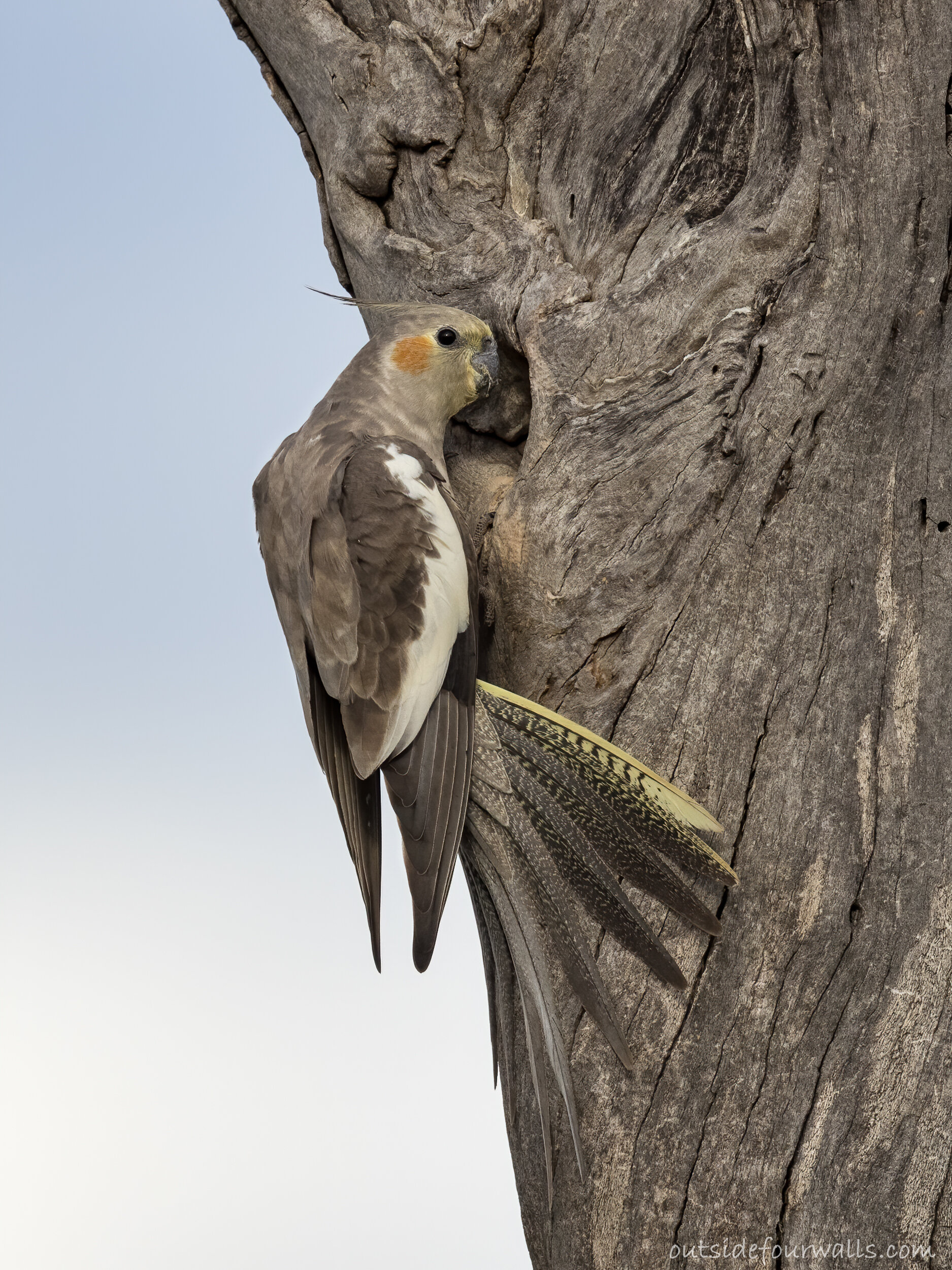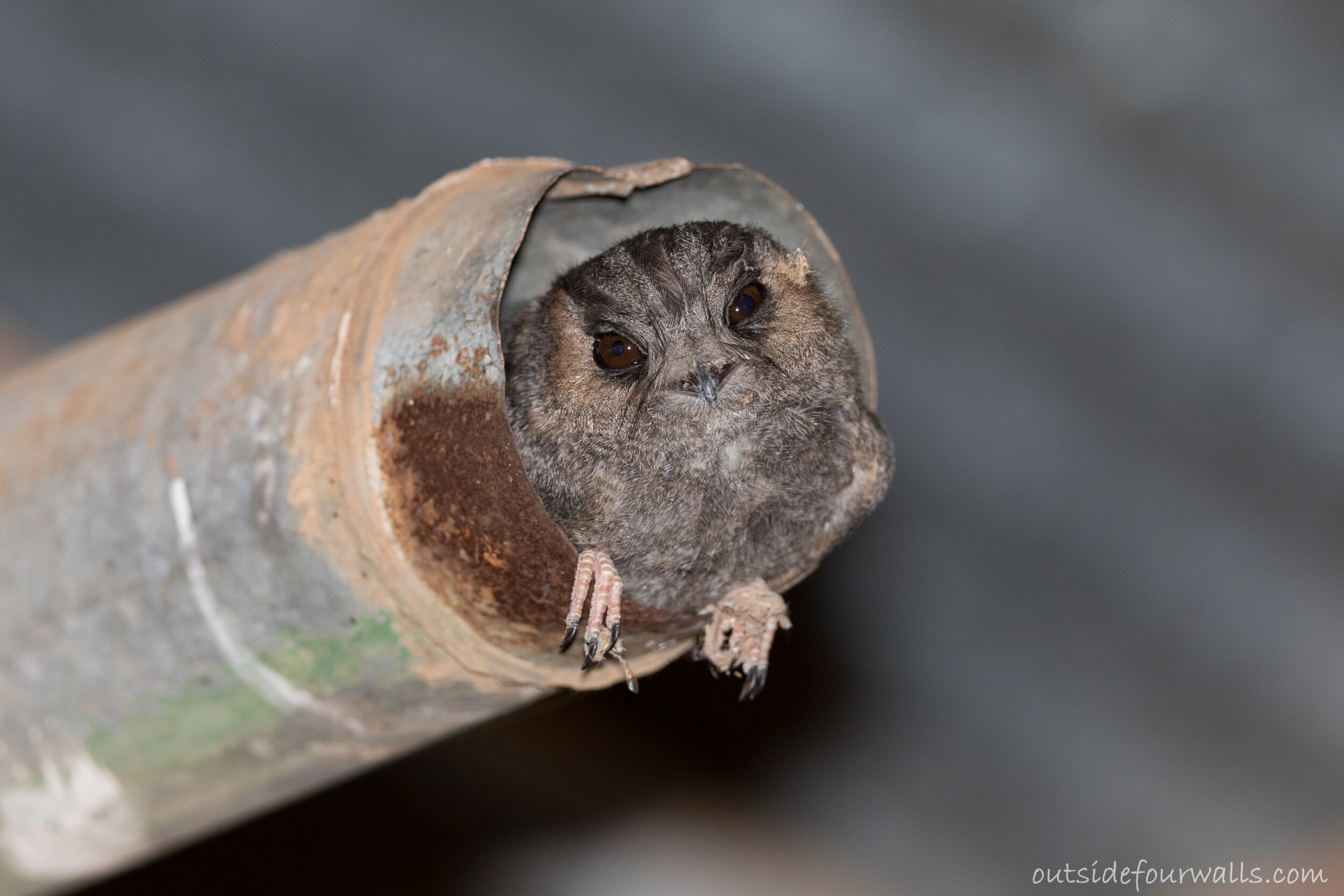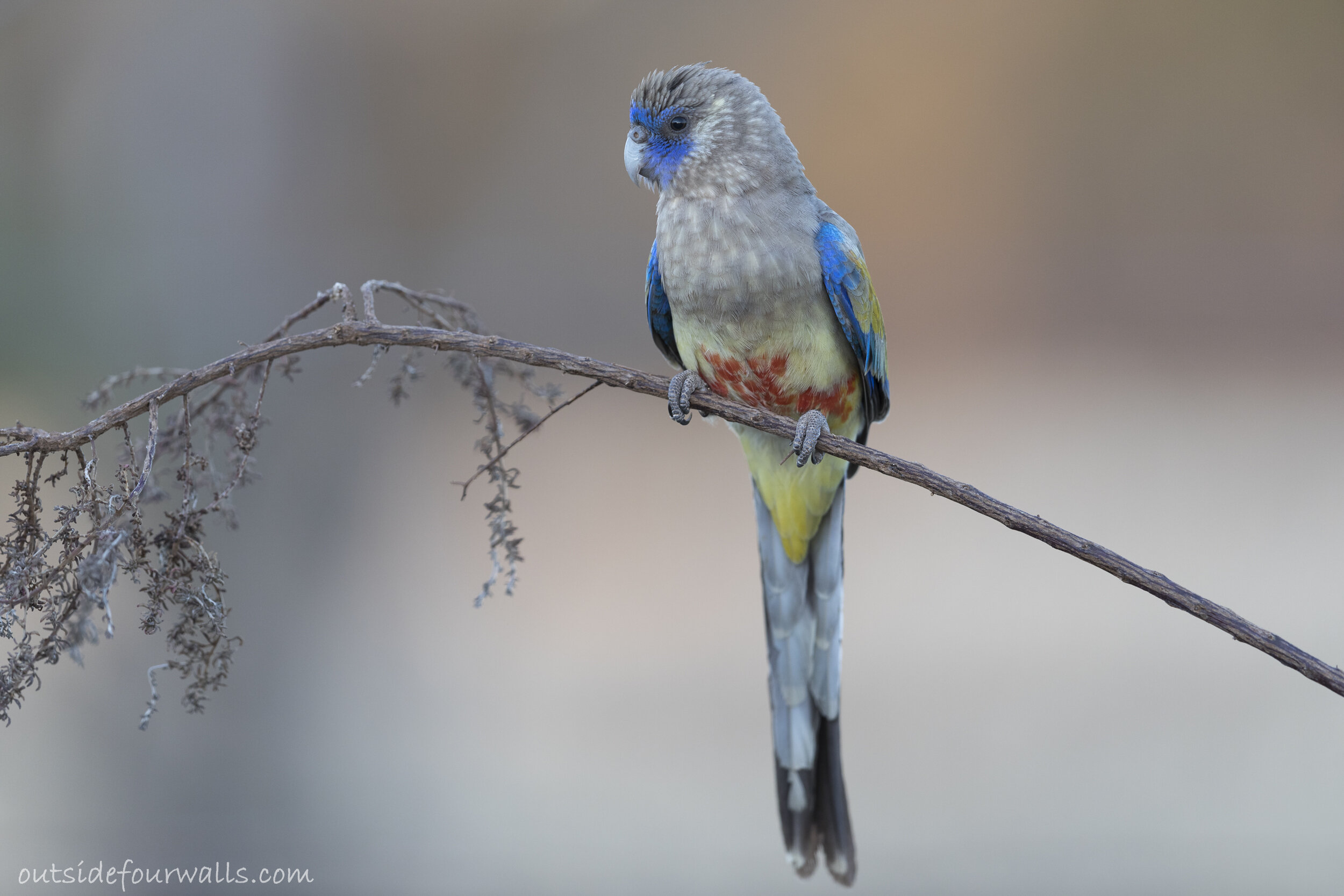Our week before Christmas turned to chaos as a bushfire in Wyperfeld National Park on Friday the 20th December spread closer and closer to our conservation reserve. But there was a silver lining of the feathered kind…
Insect experts solve our ant mystery
5km Patchewollock (not)parkrun at Yetmans Nature Conservation Reserve
ABC TV visit Explore the Mallee!
We recently had the pleasure of being interviewed by ABC TV for a story about the effects of the high rainfall last year on the environment. Spoiler alert - it’s thriving! And it was lovely to see Michael’s footage of birds used throughout the segment.
Check out the short video and full article here:
https://www.abc.net.au/news/2023-03-11/floods-transform-parts-of-outback-victoria-into-sea-of-green/102072874
Cheers,
Louise.
Unbridled joy at finding a Western Pygmy-possum (Cercartetus concinnus)
We are really fortunate to have some pretty special flora and fauna on our property, but this wee beauty has rocketed straight into two of my Top 3's - best Australian animals, and most exciting discovery on our property! Last week while out spotlighting one night with guests Richard and Gwen, I had enough of a glimpse of this animal with my thermal scanner to be 99.62% sure of what I was looking at; however, I could not see it in normal red LED torchlight as it had balled up in the middle of some gum blossoms.
So, a couple of nights later, Louise and I braved the rain to go and have another look - and we were rewarded with AMAZING clear views with the red torch that absolutely confirmed we did indeed have a WESTERN PYGMY-POSSUM!! We have wanted to see one for a long time, so to find one on our conservation reserve is a massive thrill! I snuck down again last night while out doing a pest animal patrol and was delighted to find it again in the same heavily flowering eucalypt. This time I didn't forget that the thermal scanner records video.
This utter beauty is one of the cutest animals I have ever seen - they are tiny, approximately mouse sized!
Join us on a trail running adventure in the Mallee
A love of trail running, conservation and adventure sparks unique partnership in Patchewollock.
We’re excited to announce that our venture with Melbourne’s Trail Bus is ready to roll! We’ve worked together to create a multi-day adventure in the Mallee, including trail running & conservation tours. For those coming up from Melbourne with Trail Bus, accommodation and catering will be provided by Patchewollock Hotel.
For locals in the Mallee, choose the “meet out there” option and enjoy a special discount code to save 40% off the cost of day tours! Apply this coupon code in the checkout “ETMalleelocals”.
Dates for the adventure are:
Thursday 22nd Sept: Conservation Tour at Explore the Mallee (4km)
Friday 23rd Sept: Hattah-Kulkyne National Park (10km and 16km)
Saturday 24th Sept: Murray Sunset National Park (11km or 21km)
Sunday 25th Sept: Wyperfeld National Park MEGALOOP 35km!!
Full details are available on the Trail Bus website including maps of the trail running routes, and the video below will give you a good idea of the fun we’ll have!
How did this come about? And what is trail running??
In June, Michael and I spent three days guiding Trail Bus’s Chris and Amelia around three beautiful National Parks: Hattah-Kulkyne, Wyperfeld and Murray-Sunset. They researched and mapped potential trail running routes, with a variety of distances and difficulty levels planned to cater for a range of participants’ fitness and abilities.
Trail running is an activity that is increasing in popularity, as evidenced by the large number of people who participate in parkrun, fun runs, marathons and triathlons. It can be described simply as running in nature, often at a slower pace than usual and sometimes with elements of hiking involved. Trail runners have a keen appetite for new experiences and exploring different locations.
“Michael and I started running this year, slowly building up to completing 5k. We run around our bush block, along the old railway line through our road reserve, always looking for new trails, and it gets a bit addictive. We’re keen to connect with other runners and share our knowledge of the special plants and wildlife in the Mallee,” said Louise.
Trail Bus tours are conducted safely, sustainably and ethically, with care and respect for the different environments they visit. Their values align strongly with our passion for conservation and promoting the stunning natural beauty of the Mallee.
After running down to Lake Becking in Murray Sunset National Park, Founder of Trail Bus, Chris Wright, said “It’s incredible, the trail coming down to this pink lake, I’ve never seen anything like it, such a beautiful landscape! Standing under the Bulokes, listening to the wind going through the leaves, having complete silence, its mind blowing. Getting to know these areas has opened up so many possibilities and we’re excited to get other people up here to see the beauty of the trails and the area.”
In the scoping phase, the Trail Bus crew were certainly well fed, each day ended with dinner and accommodation at Patchewollock Hotel. This partnership was supported by a Spark Tank Business Innovation grant from Yarriambiack Shire Council – many thanks!
With all the planning completed, now it’s time to join in the adventure, so we hope to see some of you out on the trails this month!
Cheers,
Louise.
All hail merino thermals and wonderful Striated Grasswrens!
Winter day trip report: Hattah-Kulkyne National Park
It was an extremely cold start to the morning with a meagre 1c on the thermometer as I left the house to pick up my guest Lynley who was visiting from Gippsland. The first surprise was a Blue-faced Honeyeater before we had even left Patchewollock! The first time I have seen one here in town so a good start to the morning. A short while later, I found Lynley her first lifer for the trip as we passed through Patchewollock State Forest; a quick view of a female Chestnut Quail-thrush made me pull over before the male happily came trotting out in front of the parked car giving us fantastic, relaxed looks from the comfort of the heated vehicle.
A quick 'pre-Hattah' stop in wonderful triodia habitat brought us a few Yellow-plumed Honeyeaters, quite a few Weebills and fantastic views of a pair of Crested Bellbirds, and another pair of Chestnut Quail-thrush but in the icy winds, not a lot else apart from an almost complete loss of feeling in our fingers and tip of nose! It is always great to see a pair of sexually dimiporhic birds (when males and females look different to each other) at the same time as you can really highlight the points to look for on each gender.
Due to the still freezing winds I decided to reverse my normal tour route so that we ended up back in triodia country on the western edge of Hattah in the afternoon, when hopefully it would be warmer and the small target birds would be more active. Definitely a bloody good idea!
Picking up the majority of the target birds (such as Regent Parrots, Apostlebirds, Whistling Kite, Brown Goshawk, White-bellied Sea-eagle, Musk Ducks for instance) throughout the southern end and the middle of the park, we headed to Lake Mournpall for lunch. Seriously, those Noisy Miners have some balls! They were literally picking crumbs inches away from our hands. I know they annoy a lot of people but they are good looking birds and one young bird was definitely entering cute territory.
With a bit of sustenance, we were ready to go and try for the trickiest pair of Mallee birds over in the west… the Mallee Emu-wren and Striated Grasswren.
Spoiler alert: we found the Grasswrens.
Striated Grasswren (Amytornis striatus)
En route we stopped at a bit of habitat which I expected to be good for smaller bush birds, and we hit a bit of an active patch for a feeding flock of mainly Southern Whiteface, but accompanied by Chestnut-rumped and Yellow Thornbills, Weebills and another pair of Crested Bellbirds - this was also the only spot we found Splendid Fairywrens. The rest of them must have been sensibly ensconced in a warm bush somewhere as despite the sun beginning to crack through the cloud, it was still bloody cold despite me having clad myself in merino before leaving the house. Yes, I am a wuss! I love warmer weather, haha.
We moved on and stopped at a location I last saw Striated Grasswrens; grabbing our binoculars and strapping on our cameras we locked the car and then as we went to head in, a familiar car was heading towards us - it was mutual friends to both Lynley and I, more Gippsland birders Rob and Jill. Rob and I had only just made a successful twitch together to see Bustards a couple of days earlier. Working on the theory that more eyes/ears may be useful, we headed in as a team to try and find small bundles of feathers in a veritable massive field of needlestacks. Within five minutes, Lynley has picked up the diminutive call of the birds to her left and as we turned to look I saw the first of the group shoot out and hop between the hummocks - success! Top job, Lynley! In the end we all had truly wonderful views of a group of 4 birds as they zigged and zagged their way through the spiky alleyways of the triodia - one even allowing us a whopping 0.386 seconds of remaining in the open AND in sunlight - none of us wasted that opportunity to get some highly sought after proof of life shots :) A new bird for Lynley, Rob and Jill’s lists.
It was an exhilarating and magical way for Lynley and I to wrap up the days birding, and some of the best views I have personally had of these elusive wee beauties.
Despite the Antarctic conditions (OK, maybe not quite but it felt like it at times!) and the low numbers of the various birds we saw - for instance only one Spiny-cheeked Honeyeater - we still ended up with a very respectable day list of 56 species. Not bad for a Mallee winter’s day… thanks Lynley for the great company.
Striated Grasswren (Amytornis striatus)
At last, a podcast on Malleefowl: listen to us on “Look at Me”
Michael and I were delighted to share exciting moments of monitoring Malleefowl mounds on an episode of The Guardian’s “Look at Me” podcast. I’m getting a bit of a reputation for talking about animal poo (or scat) a lot, and this is strongly reinforced towards the end of this episode. Somehow, I end up being described as both “wholesome” and “weird” because of it!
Hosted by science journalist Rae Johnston and ecologist Chris McCormack, from Remember the Wild, the Look at Me podcast series is one of our favourites because it focuses on unusual Australian animals. The animals that aren’t so cute (like the eye-less marsupial mole, and the Giant Gippsland earthworm), or animals that are really hard to find (like Malleefowl) finally get their time in the spotlight.
It’s hard to remember what our lives were like in a pre-Malleefowl era. We’re lucky to see these elusive birds on our property here in Patchewollock, often with the added bonus of showing our eco-tourism guests as well. Michael and I were interviewed as part of this podcast as we volunteer with the Victorian Malleefowl Recovery Group to do annual monitoring in Wathe Flora and Fauna Reserve. It’s fantastic to be part of “potentially the largest single-species citizen science project IN THE WORLD” (that quote comes from Chris McCormack on the podcast so it must be true!) and to do some “bushwalking with purpose” each year in the Mallee.
We hope you enjoy listening to this episode as much as we did.
Ps. Patchewollock and the famous spilt grain incident gets a mention, as it should, being the most talked about Malleefowl story in the Patchewollock Hotel if you ever choose to identify as a bird nerd in the pub!
The Mallee: A journey through north-west Victoria
We were honoured to feature in “The Mallee”, a book that captures life in the small towns of north west Victoria, the farms that surround them and the growing interest in tourism in the area. It’s a brilliant book, with stunning images taken by five renowned documentary photographers.
I settled down on a rainy day and read it from cover to cover, learning about the interesting history of the area. Local lad, Adam McNicol, writes beautifully and includes personal anecdotes from his time spent growing up on a farm in Manangatang, making it quite moving to read.
The Mallee book is sitting on the coffee table in our accommodation, “The Roost”, so if there happened to be a rainy day on your trip (or more likely if it was too hot to venture out in the middle of the day) you’ll have great reading material! Otherwise you can buy it online at Ten Bag Press.
Cheers,
Louise.
Photo courtesy of Melanie Faith Dove
Cockatiels checking out hollows
Cockatiels arrived mid September, treating us to daily flyovers in small groups of three to four birds. There was much squealing and excitement (from us and our guests) when a pair hung around one morning to check out hollows! Fingers crossed they choose to nest in one of our old gum trees.
Last year was much drier and we only had one brief glimpse of cockatiels on our property, although they were seen across the mallee moreso. This year it’s a bit surprising to see them so regularly, considering the wetter conditions. We thought they would have less reason to visit further afield if food is plentiful in their usual feeding grounds. Maybe they liked their holiday in the mallee last year and decided to come back!
Winner of the Cutest Bird Award!
We'd been hearing this gorgeous Owlet-nightjar calling during the day (January 2020), and being a nocturnal bird, this caught our attention. Despite looking around the most likely tree hollows behind our shed where we thought it was calling from, we couldn't find it. Turns out it was roosting IN the shed, in a pipe, high up in the rafters, maybe taking advantage of the shade and respite from the heat.
They are quite small, this pipe is around the size of a tennis ball. It seems to be used to us coming in and out of the shed now, sometimes disappearing back into the pipe if it wants some privacy. Our guests have absolutely loved seeing it and every single photo is nearly identical to this one, but that in no way diminishes the joy that everyone feels when seeing the winner of the Cutest Bird Award!
Abundance of Blue Bonnets
As the weather warms up our bird baths are becoming more popular. Most afternoons a flock of Blue Bonnets come in to bathe and drink before sunset, and we’re lucky enough to spy on them as we eat our dinner!
The cuckoos arrived early!
Parrots inspecting hollows for nesting
We have old gum trees around the house and where branches have broken off there are now hollows that provide essential nesting habitat for parrots. Over the last few weeks we’ve noticed Blue Bonnet Parrots, Red-rumped Parrots and Galahs checking out hollows of different sizes. All three of these species are regularly seen around our property so fingers crossed some of them decide to nest here.
- Louise.
Eagles munch on fox
Michael has been busy doing pest control and unfortunately that involves shooting foxes and rabbits. But over the last few weeks he was perplexed by a little mystery and has finally solved it, with surprising results!
He’d noticed that the fox carcasses were disappearing and he couldn’t figure out what was taking them (no obvious tracks or clues). So he left the next fox carcass in a sandy area and stuck a motion sensor wildlife camera on it to capture footage of the culprit. It turned out that ravens were the first to dine, followed by two Wedge-tailed Eagles, then finally a young fox drags off the grisly remains. After five days there was nothing left, but the mystery had been solved.
- Louise.
Emus out for a family stroll
Our usual view of Emus is a brownish/grey blur, sprinting through the fields as soon as they see us coming. So it was lovely to capture this footage of an adult male taking his family for a leisurely stroll. The soft whistling peeps of the chicks and their striped patterns are beautiful.
Emus have rather unbalanced parenting roles. After the female lays the eggs she moves on and the male incubates them by sitting on the nest for nearly two months. After hatching, the chicks stay with their Dad for four to six months.
- Louise.
Here’s a group of older Emus, very inquisitive of the wildlife camera!
- Louise.








